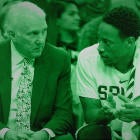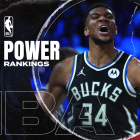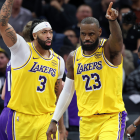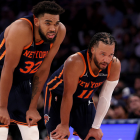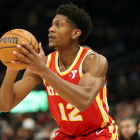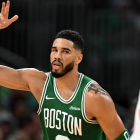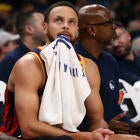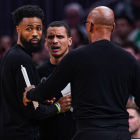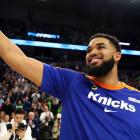By virtually any measure, the NBA's best players are playing less basketball than they used to. During the 2009-10 season, for instance, 39 players suited up for all 82 games. Last season, that number fell to 21. The league's leader in minutes per game last season was Bradley Beal. He played 36.9 minutes per contest, a figure that was topped by 22 different players during that 2009-10 campaign. The average All-NBA selection played 34.35 minutes per game last season. Go back to the 2004-05 season, and that figure jumps all the way up to 38.31.
This load-management craze has drawn outrage on behalf of both ticket-buyers and television-viewers, but the group struggling most directly with this new world is the gambling community. Picking games under normal circumstances is difficult. Picking them without knowing who will play in a given game is significantly harder. But on a game-by-game basis, bettors are faced with far more variance than they once were. The average NBA team used 17.4 different starting lineups a decade ago. That number has jumped to over 20 now, and given the widespread adoption of resting superstars, numbers like that are only expected to grow.
But with such variance comes opportunity. There are few hard and fast rules when it comes to making picks in the context of resting stars, but some of the sharpest minds in the betting world are beginning to adjust to the new reality of modern basketball.
SportsLine Data Scientist Stephen Oh, for instance, has made adjustments to his own model to reflect this uncertainty, and it has already begun paying dividends. Picks graded as "A-rated" by his model strongly favor one side in games against the spread while also carrying a significant sample of previous statistics to support its own findings, and those picks have been correct 53.1 percent of the time over the past five years. There was a dip during the 2016-17 season, though, to 49.1 percent, forcing Oh to adjust.
The biggest change came in evaluating team defense. "I use past stats to determine how good or bad a team's defense will be in key areas like defensive field goal percentage," Oh explains. "With load management, I have to determine if a historical game is relevant to the upcoming game. So if Kawhi Leonard were active then I would rely on past stats in games that he played and downgrade (or in some cases completely disregard) the stats from games he did not play in."
Sure enough, the model jumped back up to 52.9 percent on A-rated picks for the 2017-18 season, and then 54.3 percent last season. He has factored these lessons into his season-long models as well, particularly when it comes to the league's most prominent team.
"The Lakers are at 50.5 wins in Vegas (fifth most in West) but their NBA Champ odds are 4/1 (second in West) indicating that Vegas, and most people, feel like load management will limit their regular-season wins," Oh said. "I think LeBron [James] and the Lakers can't assume anything after last season. If they think they can cruise and just turn it on, then they could find themselves eighth in the West. I think their need to prove that they are as good as they think they are will force them to come out of the gate fast. If they have success then they can "cruise" to over 50.5 wins, but if they find they need to go 100 percent just to stay in top-four seed competition they'll do that as well."
Oh estimates that, on average, load management costs teams between 1.5 and 2.5 wins per season. The trouble is, not all superstars or teams are created equal. Last season's infamous example was Leonard. The Toronto Raptors went 16-6 against the spread without him last season, but as SportsLine's Jacob Gibbs explained, there are statistical markers to look out for in such situations. He found plenty of success with a similarly deep team: the Golden State Warriors.
"In the 2017-18 season, the Warriors would receive an identical line movement when Stephen Curry would be out or rested as when Kevin Durant was out. Vegas treated them as if they had the same value as players for the team, when advanced on/off splits clearly did not back that up. Per cleaningtheglass.com, the Warriors were plus-13 points per 100 possessions with Curry on the floor, as opposed to just plus-1.6 when Durant was on."
Curry missed 31 games in that season, 25 of which Durant played in. In those 25 games, the Warriors went 10-14-1 against the spread. Durant, however, missed 14 games, eight of which Curry played in. In those eight games, the Warriors went 6-1-1 against the spread. Curry and Durant suffered legitimate injuries, but the same basic idea applies to voluntary rest.
The Raptors, for instance, had thrived for years with Kyle Lowry leading bench units while DeMar DeRozan sat. Statistically savvy bettors realized that before Las Vegas did and cashed in. That 16-6 record came with an 11-3 start before lines adjusted properly.
So what teams fit the bill this season? An obvious candidate would appear to be the San Antonio Spurs. They kicked off the resting fad as a method of extending the career of Tim Duncan, and while DeRozan isn't exactly old at 30, the Spurs have a backcourt logjam to consider. In addition to DeRozan, Gregg Popovich needs to find minutes for playoff standout Derrick White, the returning Dejounte Murray, Summer League star Lonnie Walker and rotation stalwarts Patty Mills and Marco Belinelli.
So which NBA teams sail past their projected win totals? And which team falls short by double-digits? Visit SportsLine right now to see which teams you need to back or fade, all from the model that returned more than $3,000 in profit on top-rated NBA picks last season! Join SportsLine today and use promo code TROPHY to get your first month for only $1. Get every pick now!
DeRozan has a player option for the 2020-21 season, and could easily leave the Spurs. That would suit San Antonio just fine, as it outscored opponents by 4.4 points per 100 possessions when he sat last season. When he played? The Spurs' net rating was zero. He is the sort of name that could inspire line movement, but factoring in the young talent behind him and San Antonio's history of resting players, there could be plenty of value if the Spurs decide to treat him cautiously this season.
As with any seismic change in the way that a sport is played or analyzed, the gold rush won't last forever. There is opportunity at the moment, but eventually, the books are going to adjust. Given the preponderance of superstar movement this offseason, the key to capitalizing on this trend will be studying numbers like this early in the season. An informed bettor is a successful bettor.








